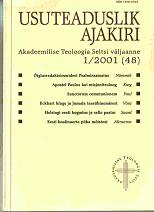Stahlist Salumäeni
From Stahl to Salumäe
Author(s): Toomas PaulSubject(s): Christian Theology and Religion
Published by: Akadeemiline Teoloogia Selts
Keywords: Hymnals; Estonian Church History
Summary/Abstract: The paper deals with some aspects of the formation of the Estonian hymnal. The first surviving hymnal written in Estonian is the 2nd part of Heinrich Stahl.s Hand- und Hauszbuch that contained 144 hymns in prose translation. The first metrical hymnal Neu Ehstnisches Gesangbuch was published in 1656 and contained 241 original or translated hymns of the best local poets Georg Salemann, Reiner Brockmann, Martin Gilaeus and Heinrich Göseken. The hymnal used in the churches has been successively improved in the following centuries, and the collection of the hymns has been altered. Kiriku Lauluja Palveraamat [The Church Hymnal and Prayer Book], in use from 1991, has been completed under the supervision of Ivar-Jaak Salumäe. Sad to say the process of the formation and revision of the Estonian hymnal has been totally neglected by the researchers. One of the reasons of that negligence has been due to the fact that to the end of the 19th century the Estonian clergy was almost hundred percent of the German nationality. During the period of the National Awakening the Estonian intellectuals started to withdraw from the German culture and took pains to create the Estonian culture. The church and the sacred literature were considered to be a stranger.s business. The opposition has not disappeared even at present. The Estonian poets of the 20th century have stayed aside from the creation of the hymns. The history of Estonian literature concerns itself only with the 1637 and1656 publications, the following ones are simply considered to belong to the conventional literature and the researches have not been interested in them. But still, the hymnal has been the most important book in the lives of the Estonian people for many centuries, much widely spread even than the Bible. The hymns that people have listened and memorized from childhood could not remain without any influence. It is necessary to study which hymns have been sung, how and why the hymnal have been altered, and how the hymnal has affected the people.s mentality. The paper ends with a proposal to the theologians to research the history and the significance of the hymnal of the Estonian church.
Journal: Usuteaduslik Ajakiri
- Issue Year: 2001
- Issue No: 2 (49)
- Page Range: 61-78
- Page Count: 18
- Language: Estonian

